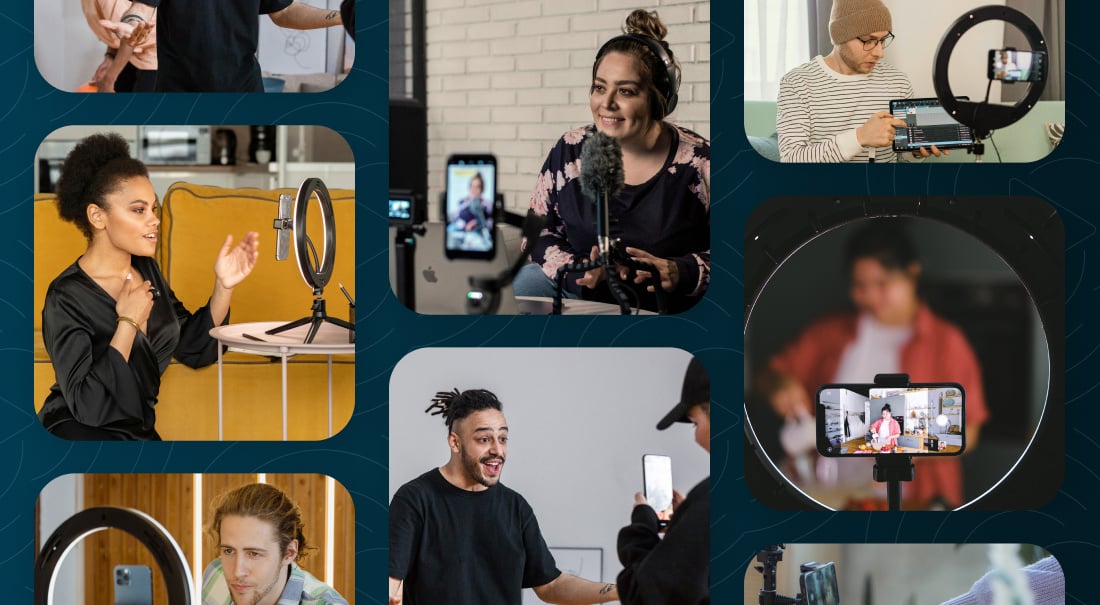
If you want to start from scratch, here are the most important elements for creating a content calendar. Similarly to a social media content calendar, your video content calendar should consist of several key components:
Map out a monthly overview
We strongly encourage you to plan a month in advance. While it is possible to create a weekly video production cadence, you might find yourself flying by the seat of your pants more than you care to! Building out your content plan 30 days at a time positions you to work on multiple things at once without the fear of missing a deadline.

Define your campaign language
Labeling your video content clearly and consistently is crucial. (Sorry for the alliteration.) For example: If you’re an e-learning instructor, you’ll want to establish campaign labels to maintain organization of your lessons — especially if you’re managing a team of people. This also means researching and including important keywords and key phrases you want to include in your content (more on that later).
Determine the best publishing times
Knowing what day you’re going to publish and distribute a video is great, and knowing what time is just as important. Research and understand optimal publishing times for each channel; or, set your own time frame.
Just make sure you're consistent, and that your audience knows when to expect your recurring content. It’s almost impossible to grow a dedicated following without giving your audience a reliable schedule.
Video content planning
Video content planning is a crucial aspect of content creation for video creators: It serves as the foundation for long-term success. With video consumption at an all-time high, creators have to recognize the significance of thoughtful planning to. . .
-
Capture their audience’s attention
-
Convey a compelling message
-
Create long-term success
Know your content’s purpose.
Effective video content planning allows creators to define their purpose and goals. Understanding the core message, target audience, and desired outcomes helps shape the entire content creation process. Without a clear plan, creators risk producing content that lacks direction and coherence — potentially leading to viewer disengagement. Defining objectives ensures that every piece of content serves a clear purpose.
A well-thought-out plan helps creators maintain consistency in their content. Consistency is key in building a loyal audience, as viewers come to expect a certain style and tone from their favorite creators. A content calendar and strategic planning enable creators to organize their ideas, schedule releases, and ensure a steady flow of content that aligns with their brand and resonates with their audience.
Get the most bang for your buck.
Video content planning also plays a pivotal role in optimizing resources and maximizing efficiency. Creators can identify themes, trends, and relevant topics in advance, allowing for better utilization of time and resources. This foresight enables the exploration of diverse content angles, helping creators stay relevant and innovative within their niche. By avoiding last-minute rushes, creators can focus on enhancing the quality of their videos, refine their storytelling, and incorporate engaging elements that captivate their audience.

Additionally, planning allows for effective storytelling, which — as everyone knows — is a cornerstone of successful video content. Creators can structure their videos in a way that captivates viewers from the beginning, maintains their interest throughout, and leaves a lasting impression. Storyboarding, scripting, and pre-production in general contribute to a cohesive and compelling narrative that will resonate with the audience emotionally and intellectually.
Find your audience — and keep them around
Strategic video content planning also contributes to audience retention and engagement. By analyzing data and trends, creators can tailor their content to the preferences and behaviors of their audience. This data-driven approach allows for content creation that not only attracts but also retains viewers, ultimately building a community around the creator’s brand. Understanding audience demographics, interests, and feedback informs content decisions, fostering a stronger connection with the audience.
In short: Video content planning allows for adaptability in this rapidly evolving landscape of online content creation.
Trends and algorithms change, and creators need to be agile in responding to these shifts. A well-structured video content calendar provides a framework that allows creators to pivot when necessary, experiment with new formats, and stay ahead of the curve in terms of content innovation.
By investing time and effort into strategic planning, creators can elevate the quality of their content, strengthen their brand presence, and build a loyal and engaged audience over time.
Tracking content performance
Once you’ve got your video content calendar in place, the next step toward growing your channel and brand is understanding how your videos are performing.
To do this, you’ll use calls-to-action (CTAs) with “tracking identifiers” in your videos. Tracking identifiers like custom landing page URLs, tracking URLs, and UTMs (which are unique extensions of your URL) let you track which videos (or series or campaigns) triggered which behaviors among your audience.
Marketers typically use things like cookies, pixels, IP addresses, and user IDs to track who takes which actions on their websites, emails, and apps. But there’s no way to implement these types of tracking tools in videos hosted and played on third-party sites like Facebook, LinkedIn, and YouTube.

In anticipation of eventually evaluating the effectiveness of your live videos, include CTAs in every live video. You can state them out loud, include them as text overlays or corner bugs, or include them in the post text below your videos. Ideally, you’ll do all three. And make sure that these CTAs always include a trackable URL or code. (Here’s a free URL builder to get you started — it lets you add unique campaign parameters to an existing URL so that you can track where it was used.)
Tip: If you don’t want to include a long URL in your video, add the tracking parameters and then use a link-shortening tool like Bitly, or just create a custom URL that redirects to the right page.
If you’re livestreaming content, you’ll use your analytics tool(s) to see how your videos (or video campaigns) translated into met goals. You can use Google Analytics goals (which you set up in the Admin panel and access under the Conversions tab) to set up tracking for your goals.
Plan, create, and grow
Planning ahead helps you create better content, and understanding how your content performs out in the wild helps you grow your channel. Tools like Switcher Studio can help you every step of the way.
After you download your free content calendar template from Switcher, you can take advantage of our suite of tools and features to create engaging video content, grow your following, and even start earning sustainable revenue from your videos.
Ready to see how easy it is to streamline your video production and take your video further? Sign up for Switcher for free for 14 days
Subscribe to the blog
Sign up to receive notifications whenever a new blog post is published. You may unsubscribe at any time.






